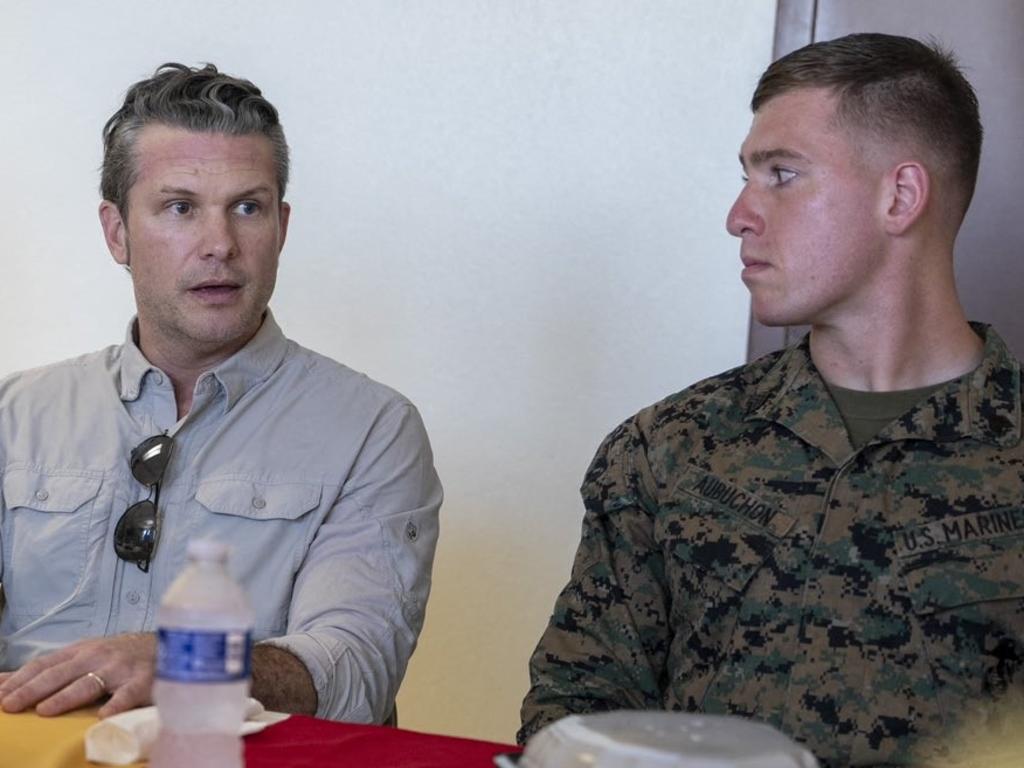
You get the sense that the US-Australia alliance could be moving towards a dangerous crisis point.
One flashpoint could emerge any day: the completion of the AUKUS review by Elbridge Colby, the Pentagon’s Under Secretary of Defence for Policy.
Colby is examining whether the AUKUS agreement fits Donald Trump’s America First policies. Colby is an AUKUS sceptic because he doesn’t think the US will have enough nuclear-powered subs of its own to sell one to Australia in 2032.
It’s possible the review will be released while Anthony Albanese is on his extended trip to China, basking no doubt in schmoozing and compliments.
The official apparatus of the People’s Republic of China is superb at flattering foreigners it wants to influence, though it’s hard to imagine it can get much more oleaginous than describing our estimable PM as “handsome boy”.
Still, even the Prime Minister may feel jaundiced if he finds it necessary in Beijing to answer questions about his own contribution to the death or dismemberment of AUKUS. That probably won’t happen. The review could well take longer than its scheduled 30 days.
If its conclusions are significant there may be an interagency review afterwards. Anything that bore fundamentally on the alliance would have to go up to Trump himself.

We’re still not sure whether this review is a personal initiative of Colby’s, a full-fledged institutional Pentagon project or something that can be seen as representing the Trump administration altogether.
The majority of public comment about the Colby review has, understandably, focused on his reasonable doubts as to whether the US could possibly afford to sell first one, or eventually in total three, Virginia-class boats to Australia when it will be severely short of such boats itself.
A nuclear-powered sub takes about seven years to build so we already know how many US subs there will be. The AUKUS agreement stipulates the US president in 2031 has to be sure selling a sub to Australia the next year won’t diminish the US Navy.
There are two other threshold questions for Colby. Is the US-Australia alliance strong enough that Washington would believe Australian navy submarines would help our ally in any conflict in the Pacific?
That this is a question shows how badly the alliance has run off the rails. The ANZUS Treaty itself calls for the allies to respond if their territory or their forces are attacked in the Pacific.
The precise question of how Australia would respond in a conflict is subject to a simple but unavoidable paradox.
No alliance arrangement absolutely commits any nation to take action in some unforeseeable future contingency.
So no Australian government could give a formal commitment, in advance, that it would join the US in any military engagement with the PRC. However, in reality it’s almost inconceivable that Australia wouldn’t join the US in such circumstances.
The most likely event would be conflict over the PRC trying to take Taiwan by force.

As the great Rich Armitage once put it to an Australian audience: if American service men and women are fighting and dying to secure a Pacific democracy, and Australia stands on the sidelines, the US-Australia alliance could not possibly endure.
Moreover the presence of US joint facilities such as Pine Gap, and other US forces in Australia, means that in a real war the PRC would almost certainly attack Australia at the outset anyway.
Not only that, if there were any chance at all we would participate, the PRC would have an incentive to attack our air force, whose bases are completely unprotected, and our submarine base, as these two assets, modest as they are, could be usefully deployed in such a conflict.
But now, under Albanese and Trump, the alliance is more distant than it has been at any time since the erratic and disastrous Gough Whitlam prime ministership. So it’s not quite so clear the Americans could rely on us as we routinely rely on them.
A new edition of the Geoffrey Blainey classic, The Causes of War, has just been issued. In it Blainey argues persuasively that neither war nor peace is the natural state of relations between nations. Both rather are methods for advancing national interests and policy objectives. Blainey calls for a much deeper analysis of the causes of peace.
One of the most effective causes of peace is a stable system of deterrence. US Secretary of Defence Pete Hegseth gave important congressional testimony last month. He nominated the PRC as the chief threat to the US, its stated intention of taking Taiwan by force if it chose as something Washington was determined to prevent. He said Beijing was preparing for war.
The US could deter this, however, by modernising and expanding its own forces and by “strengthening our forward posture in the region and working closely with our allies to enhance their own defence capabilities”. He specifically nominated Australia, Japan and The Philippines.
So Hegseth is clear about what should be obvious: the presence of US forces in Australia, and our co-operation with US forces, is part of a conscious military deterrence against Beijing. Albanese will never speak publicly of any of these matters now.
Another big question for Hegseth is whether Australia will be technically capable of running nuclear subs by 2032. In this connection we have indirect but devastating evidence of gross Australian incompetence.
The Australian National Audit Office published a dismal report that produced shocking chapter and verse about the navy’s inability to maintain in reliable service its landing helicopter dock ships.
There’s a lot of depressing and terrible detail in this report. But it all boils down to this.
If the Australian Defence Force is routinely defeated by the challenge of manning and running LHDs, under what moon of madness would anyone think it can run Virginia-class nuclear submarines, one of the most complex artefacts ever constructed by humanity? If we were serious about doing any of this we would have put in huge effort already.
Here’s a final historical note.
In 1963, Labor’s parliamentary leaders Arthur Calwell and Whitlam were sensationally photographed sitting docilely outside a meeting of Labor’s national conference, its 36 “faceless men”.
The parliamentary leadership wasn’t included in the party’s decision-making body in those days. It was meeting to consider whether Labor would support the establishment of the US facility at North West Cape, which was vital in US submarine communications. The left of the party was in uproar, determined to reject this US facility.
One of the leading left opponents of North West Cape was Tom Uren, the MP for whom Albanese, as a fellow member of the party’s far left, later worked and idolised for so long.
Just what kind of government has Labor’s huge election victory delivered us?





